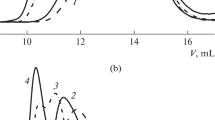Abstract
Due to manifold application possibilities in important modern technologies, three-dimensional polymeric networks attract attention of many researcher groups. Simultaneously, many attempts have been made to describe theoretically the behavior of polymeric networks. Generally accepted modern theories predict that networks acquire a noticeable flexibility only in the case that the distance between two neighbor junction points exceeds the length of chain segments. Therefore, slightly or moderately crosslinked polymers, only, should be in position to swell with thermodynamical1y good solvents. With the degree of crosslinking rising, the high elasticity properties of a network should gradually disappear, the glass transition temperature being shifted rapidly toward the temperature region of thermal decomposition of the material. These fundamental properties are well documented with examination results of many types of polymeric networks, in particular, that of crosslinked polystyrene. Indeed, conventional styrene-diviny1benzene (DVB) copolymers are known 1,2 to lose their ability to swell with solvents or acquire high elastic state on heating at a DVB content exceeding 15%..
Access this chapter
Tax calculation will be finalised at checkout
Purchases are for personal use only
Preview
Unable to display preview. Download preview PDF.
Similar content being viewed by others

References
T. R. E. Kressman and J. R. Millar, Relationship between swelling and crosslinking of sulfonated polystyrene resins, Chem. and Ind., 45:1833 (1961).
J. H. Glans and D. T. Turner, Glass transition elevation of polystyrene by crosslinks, Polymer, 22:1540 (1981).
M. Seno and T. Yamabe, A note on the characterization of the network structure of the ion exchange resins, Bull. Chem. Soc. Japan, 37:754 (1964).
K. Dušek and W. Prins, Structure and elasticity of non-crystalline polymer networks, Adv. Polym. Sci., 6:1 (1969).
V. A. Artamonov and V. S. Soldatov, Study into permeability of copolymers of styrene with diviny 1 benzene, Izvestia Akad. Nauk BSSR, Ser. Khim., N 3:34 (1974).
D. A. Reshetko, On relations between processes of physical adsorption and dissolution on interaction of polymers with vapours of low-molecular-weight liquids, Ph D Thesis, Sverdlowsk, (1976), p. 176.
I-F. Khirsanova, V. S. SoldatovR. V, Marzinkevich, M. P. Tsyurupa, and V. A. Davankov, Sorption properties of polystyrene gels crosslinked with p-xylilene dichlorde, Kolloid. Zhurnal, 40: 1025 (1978).
J. Baldrian, B. N. Kolarz, and H. Galina, Small angle x-ray scattering study of porosity variation in styrene-divinylbenzene copolymers, Collect. Czech. Chem. Commun., 46: 1675 (1981).
G.I. Rozenberg, A. S. Shabaeva, V. S. Moryakov, T. G. Musin, M. P. Tsyurupa, and V. A. Davankov, Sorption properrties of hypercrosslinked polystyrene sorbents, Reactive Polymers, 1: 175 (1983).
M. P Tsyurupa, E. A. Pankratov, D. Ya. Tswankin, V. P. Zhukov, and V. A. Davankov, Morphology of macronet isoporous styrene polymers of the “Styrosorb”-type, Vysokomolek. Soed., A 27: 339 (1985).
M. P. Tsyurupa, T. A. Mrachkovskaya, L. A. Maslova, G. I. Timofeeva, L. V. Dubrovina, E. F. Titova, and V. A. Davankov, Soluble intramolecularly-hypercrosslinked polystyrene, Reactive Polymers, in press.
L. D. Belyakova, T. I. Shevchenko, V. A. Davankov, and M. P. Tsyurupa, Sorption of vapours of various substances by hypercrosslinked “Styrosorb” polystyrene, Adv. in Colloid and Interface Sci., 25: 249 (1986).
J. D. Joon, P. R. Sandararajan, and P. J. Flory, Conformational characterization of polystyrene, Macromolecules, 8: 776 (1975).
Author information
Authors and Affiliations
Editor information
Editors and Affiliations
Rights and permissions
Copyright information
© 1992 Springer Science+Business Media New York
About this chapter
Cite this chapter
Davankov, V.A., Tsyurupa, M.P. (1992). Rigid Hypercrosslinked Polystyrene Networks with Unexpected Mobility. In: Aharoni, S.M. (eds) Synthesis, Characterization, and Theory of Polymeric Networks and Gels. Springer, Boston, MA. https://doi.org/10.1007/978-1-4615-3016-9_13
Download citation
DOI: https://doi.org/10.1007/978-1-4615-3016-9_13
Publisher Name: Springer, Boston, MA
Print ISBN: 978-1-4613-6314-9
Online ISBN: 978-1-4615-3016-9
eBook Packages: Springer Book Archive



